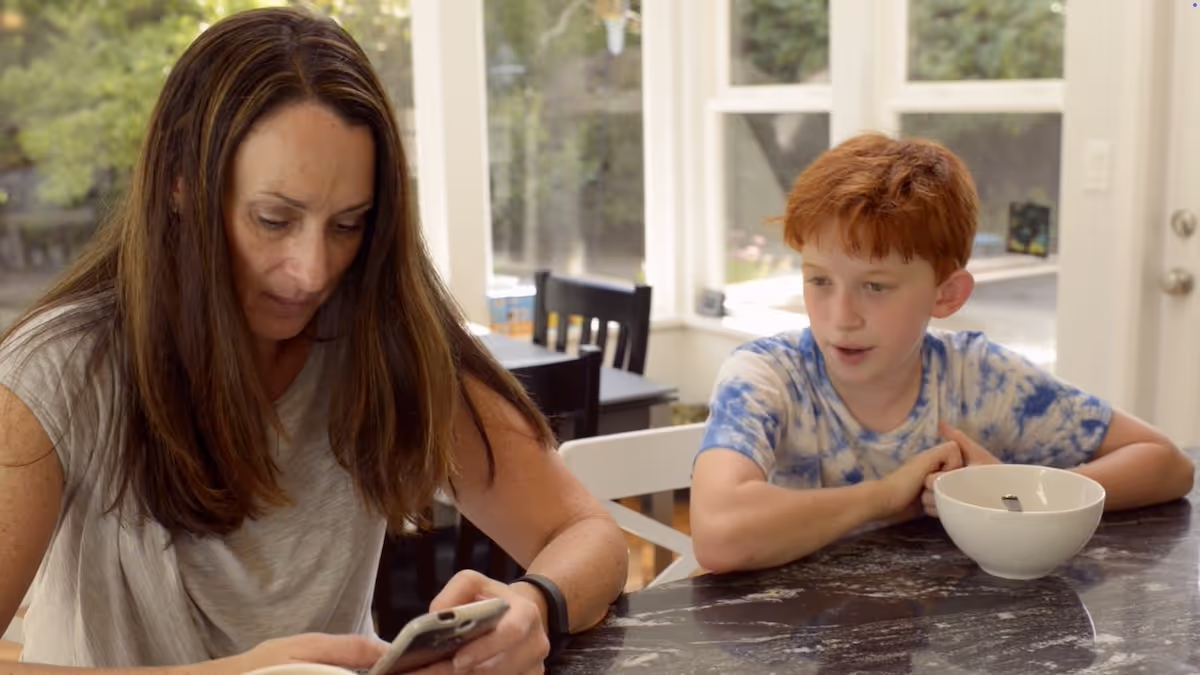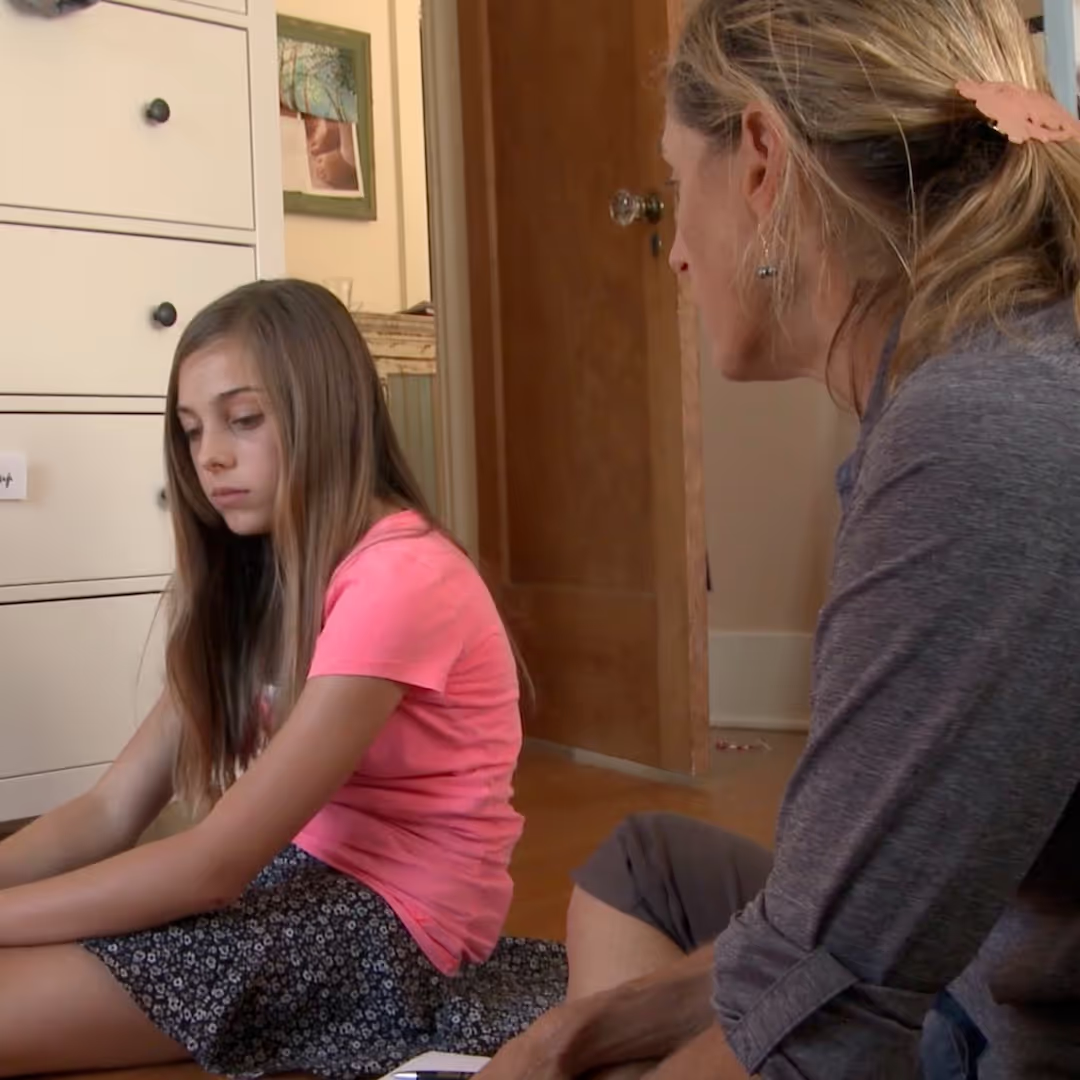


Big news has hit us this week about brain morphology and screen time, and I want to weigh in as we all try to make sense of the findings. Here is the gist of what headlines are saying:
Researchers studied 4,500 9-and 10-year olds and found that many of those who spend more than 7 hours a day on screens —such as smartphones, tablets, and video games—showed premature thinning of the cortex which is the outermost layer of the brain.
This new data comes from the ABCD study funded by The National Institutes of Medicine (NIH). I just got off the phone with neuroscientist Elizabeth Sowell PhD who leads a ABCD study site at Children’s Hospital of Los Angeles. I have some important information to share.
I met Elizabeth when The Los Angeles Unified School District asked me to speak at a Screenagers’ event in 2016. Elizabeth and her team had a booth outside the screening where they were trying to recruit youth to be in the ABCD study —there are 21 sites around the country. Not many people were coming up to the booth.
Having spent two years working at NIH as a researcher, I understood how hard it is to find people to participate in studies, and I knew this study was a game changer, so I was eager to help. During my Screenagers presentation, I told the audience all about the landmark study and the learning opportunities that their children could glean from participating in a major research study. I was so pleased that many of the audience went straight to the booth after the talk to sign up.

For this study, 9-and-10-year-olds were recruited between 2016 to 2018. Kids will be followed for a total of ten years. At their yearly visits, the children and their parents will complete questionnaires, and some years MRI scans will be done on the kids. A total of 11,000 youth have been enrolled, and scientists will be gathering important data about brain development in response to things like marijuana, alcohol, and... screen time.
The study just released included only the first cohort of 4,500 kids and it gives data based on questionnaires and MRIs of their brains at one moment in time. Researchers found that kids who spent more than 7 hours a day on screens, on average, had a thinner outer layer of their cerebral cortex than kids who spent less time on screens. The cerebral cortex is the area that houses “executive functioning” —ie, higher order thinking, such as data consolidation, problem-solving and planning. It also helps us regulate our responses to emotions that come from deeper areas of the brain.
Babies are born with many more brain cells than they will end up with as adults. Why so many cells at birth? The hypothesis is that this abundance of cells gives humans incredible adaptability to whatever environments they find themselves. As babies grow older and have experiences, these experiences dictate how neurons begin to lay down patterns. Neuronal connections that are not used, start to be pruned away. Evolutionarily, it is important that the brain loses some of what it does not use because running a brain takes a lot of energy—in fact 20% of the food we eat goes just to support the brain. Pruning promotes efficiency.
The researchers revealed thinner cortexes of these 9 and 10-year-olds. The level of thinning found is what one finds on MRIs for older children. This is why this is being called premature thinning. One could see this as a bad thing, that the brain is consolidating neurons earlier than it normally would. On the flip side, one could say that the brain appears to be maturing faster, so isn’t that a good thing?
Early maturation can sound good but the ABCD researchers found that this thinning in the cortex was correlated with lower “crystalized” intelligence. Crystalized refers to the knowledge that youth glean from simply living life, such as vocabulary (as opposed to “fluid” intelligence which is not as much about “what is known” as opposed to “how something is known”). I do not know which crystalized intelligence they measured because it is not in the science report.
Does all this have me concerned? Yes...but at this point, we have no idea if the screen time caused this thinning, or if the kids who were inclined to spend more than 7 hours on screens were more likely to have a thinner cortex to begin with. The real power of this study will come with follow-up data collection and MRI scans. The changes that will be revealed over time will help sort out cause and effect relationships.
But don’t get me wrong, this is really important information, and we need to talk with our students in schools and universities, students in afterschool programs, Boy and Girl Scouts, team sports, along with children and teens in our homes. This is the type of science that can engage young people. It is about their brains, and they do care about their brains!
In fact, last month I was in France filming their new national law to limit screen time by prohibiting cell phones in classrooms for students 15 and younger. When discussions turned to screen time at home, many tweens and teens told me how they were comfortable keeping their phones out of their bedrooms at night because they had learned that there might be problems from too much radiation exposure. Science is still looking into this, but what is telling is that that the students were concerned enough by this research to change their habits.
Today let’s use this new scientific study from ABCD to engage our youth in this important topic of screen time effects on kids’ brain development. As we sit in the middle of this tech revolution, let’s help the next generation be data-driven and scientifically minded —their input is key to creating a society committed to preventing unthwarted outcomes of excessive screen time.
Here are questions to ask your kids about the Adolescent Brain Cognitive Development (ABCD) Study.
HOST A SCREENING to help spark change.
FIND EVENT LISTINGS
Stay in touch with the Screenagers community on Facebook, Twitter and at www.screenagersmovie.com
We encourage you to share this, and other TTTs, widely with your community. You are welcome to republish this in your newsletters as long as you credit us and put a link to our TTT page. If you do this please let us know by emailing lisa@screenagersmovie.com.
As well as our weekly blog, we publish videos like this one every week on the Screenagers YouTube channel
Learn more about showing our movies in your school or community!
Join Screenagers filmmaker Delaney Ruston MD for our latest Podcast

Learn more about our Screen-Free Sleep campaign at the website!
Our movie made for parents and educators of younger kids
Learn more about showing our movies in your school or community!
Learn more about showing our movies in your school or community!
Join Screenagers filmmaker Delaney Ruston MD for our latest Podcast

Learn more about our Screen-Free Sleep campaign at the website!
Our movie made for parents and educators of younger kids
Join Screenagers filmmaker Delaney Ruston MD for our latest Podcast
As we’re about to celebrate 10 years of Screenagers, we want to hear what’s been most helpful and what you’d like to see next.
Please click here to share your thoughts with us in our community survey. It only takes 5–10 minutes, and everyone who completes it will be entered to win one of five $50 Amazon vouchers.
Big news has hit us this week about brain morphology and screen time, and I want to weigh in as we all try to make sense of the findings. Here is the gist of what headlines are saying:
Researchers studied 4,500 9-and 10-year olds and found that many of those who spend more than 7 hours a day on screens —such as smartphones, tablets, and video games—showed premature thinning of the cortex which is the outermost layer of the brain.
This new data comes from the ABCD study funded by The National Institutes of Medicine (NIH). I just got off the phone with neuroscientist Elizabeth Sowell PhD who leads a ABCD study site at Children’s Hospital of Los Angeles. I have some important information to share.
I met Elizabeth when The Los Angeles Unified School District asked me to speak at a Screenagers’ event in 2016. Elizabeth and her team had a booth outside the screening where they were trying to recruit youth to be in the ABCD study —there are 21 sites around the country. Not many people were coming up to the booth.
Having spent two years working at NIH as a researcher, I understood how hard it is to find people to participate in studies, and I knew this study was a game changer, so I was eager to help. During my Screenagers presentation, I told the audience all about the landmark study and the learning opportunities that their children could glean from participating in a major research study. I was so pleased that many of the audience went straight to the booth after the talk to sign up.

For this study, 9-and-10-year-olds were recruited between 2016 to 2018. Kids will be followed for a total of ten years. At their yearly visits, the children and their parents will complete questionnaires, and some years MRI scans will be done on the kids. A total of 11,000 youth have been enrolled, and scientists will be gathering important data about brain development in response to things like marijuana, alcohol, and... screen time.
The study just released included only the first cohort of 4,500 kids and it gives data based on questionnaires and MRIs of their brains at one moment in time. Researchers found that kids who spent more than 7 hours a day on screens, on average, had a thinner outer layer of their cerebral cortex than kids who spent less time on screens. The cerebral cortex is the area that houses “executive functioning” —ie, higher order thinking, such as data consolidation, problem-solving and planning. It also helps us regulate our responses to emotions that come from deeper areas of the brain.
Babies are born with many more brain cells than they will end up with as adults. Why so many cells at birth? The hypothesis is that this abundance of cells gives humans incredible adaptability to whatever environments they find themselves. As babies grow older and have experiences, these experiences dictate how neurons begin to lay down patterns. Neuronal connections that are not used, start to be pruned away. Evolutionarily, it is important that the brain loses some of what it does not use because running a brain takes a lot of energy—in fact 20% of the food we eat goes just to support the brain. Pruning promotes efficiency.
The researchers revealed thinner cortexes of these 9 and 10-year-olds. The level of thinning found is what one finds on MRIs for older children. This is why this is being called premature thinning. One could see this as a bad thing, that the brain is consolidating neurons earlier than it normally would. On the flip side, one could say that the brain appears to be maturing faster, so isn’t that a good thing?
Early maturation can sound good but the ABCD researchers found that this thinning in the cortex was correlated with lower “crystalized” intelligence. Crystalized refers to the knowledge that youth glean from simply living life, such as vocabulary (as opposed to “fluid” intelligence which is not as much about “what is known” as opposed to “how something is known”). I do not know which crystalized intelligence they measured because it is not in the science report.
Does all this have me concerned? Yes...but at this point, we have no idea if the screen time caused this thinning, or if the kids who were inclined to spend more than 7 hours on screens were more likely to have a thinner cortex to begin with. The real power of this study will come with follow-up data collection and MRI scans. The changes that will be revealed over time will help sort out cause and effect relationships.
But don’t get me wrong, this is really important information, and we need to talk with our students in schools and universities, students in afterschool programs, Boy and Girl Scouts, team sports, along with children and teens in our homes. This is the type of science that can engage young people. It is about their brains, and they do care about their brains!
In fact, last month I was in France filming their new national law to limit screen time by prohibiting cell phones in classrooms for students 15 and younger. When discussions turned to screen time at home, many tweens and teens told me how they were comfortable keeping their phones out of their bedrooms at night because they had learned that there might be problems from too much radiation exposure. Science is still looking into this, but what is telling is that that the students were concerned enough by this research to change their habits.
Today let’s use this new scientific study from ABCD to engage our youth in this important topic of screen time effects on kids’ brain development. As we sit in the middle of this tech revolution, let’s help the next generation be data-driven and scientifically minded —their input is key to creating a society committed to preventing unthwarted outcomes of excessive screen time.
Here are questions to ask your kids about the Adolescent Brain Cognitive Development (ABCD) Study.
HOST A SCREENING to help spark change.
FIND EVENT LISTINGS
Stay in touch with the Screenagers community on Facebook, Twitter and at www.screenagersmovie.com
We encourage you to share this, and other TTTs, widely with your community. You are welcome to republish this in your newsletters as long as you credit us and put a link to our TTT page. If you do this please let us know by emailing lisa@screenagersmovie.com.
As well as our weekly blog, we publish videos like this one every week on the Screenagers YouTube channel
Sign up here to receive the weekly Tech Talk Tuesdays newsletter from Screenagers filmmaker Delaney Ruston MD.
We respect your privacy.
Big news has hit us this week about brain morphology and screen time, and I want to weigh in as we all try to make sense of the findings. Here is the gist of what headlines are saying:
Researchers studied 4,500 9-and 10-year olds and found that many of those who spend more than 7 hours a day on screens —such as smartphones, tablets, and video games—showed premature thinning of the cortex which is the outermost layer of the brain.
This new data comes from the ABCD study funded by The National Institutes of Medicine (NIH). I just got off the phone with neuroscientist Elizabeth Sowell PhD who leads a ABCD study site at Children’s Hospital of Los Angeles. I have some important information to share.
I met Elizabeth when The Los Angeles Unified School District asked me to speak at a Screenagers’ event in 2016. Elizabeth and her team had a booth outside the screening where they were trying to recruit youth to be in the ABCD study —there are 21 sites around the country. Not many people were coming up to the booth.
Having spent two years working at NIH as a researcher, I understood how hard it is to find people to participate in studies, and I knew this study was a game changer, so I was eager to help. During my Screenagers presentation, I told the audience all about the landmark study and the learning opportunities that their children could glean from participating in a major research study. I was so pleased that many of the audience went straight to the booth after the talk to sign up.

For this study, 9-and-10-year-olds were recruited between 2016 to 2018. Kids will be followed for a total of ten years. At their yearly visits, the children and their parents will complete questionnaires, and some years MRI scans will be done on the kids. A total of 11,000 youth have been enrolled, and scientists will be gathering important data about brain development in response to things like marijuana, alcohol, and... screen time.
The study just released included only the first cohort of 4,500 kids and it gives data based on questionnaires and MRIs of their brains at one moment in time. Researchers found that kids who spent more than 7 hours a day on screens, on average, had a thinner outer layer of their cerebral cortex than kids who spent less time on screens. The cerebral cortex is the area that houses “executive functioning” —ie, higher order thinking, such as data consolidation, problem-solving and planning. It also helps us regulate our responses to emotions that come from deeper areas of the brain.
Babies are born with many more brain cells than they will end up with as adults. Why so many cells at birth? The hypothesis is that this abundance of cells gives humans incredible adaptability to whatever environments they find themselves. As babies grow older and have experiences, these experiences dictate how neurons begin to lay down patterns. Neuronal connections that are not used, start to be pruned away. Evolutionarily, it is important that the brain loses some of what it does not use because running a brain takes a lot of energy—in fact 20% of the food we eat goes just to support the brain. Pruning promotes efficiency.
The researchers revealed thinner cortexes of these 9 and 10-year-olds. The level of thinning found is what one finds on MRIs for older children. This is why this is being called premature thinning. One could see this as a bad thing, that the brain is consolidating neurons earlier than it normally would. On the flip side, one could say that the brain appears to be maturing faster, so isn’t that a good thing?
Early maturation can sound good but the ABCD researchers found that this thinning in the cortex was correlated with lower “crystalized” intelligence. Crystalized refers to the knowledge that youth glean from simply living life, such as vocabulary (as opposed to “fluid” intelligence which is not as much about “what is known” as opposed to “how something is known”). I do not know which crystalized intelligence they measured because it is not in the science report.
Does all this have me concerned? Yes...but at this point, we have no idea if the screen time caused this thinning, or if the kids who were inclined to spend more than 7 hours on screens were more likely to have a thinner cortex to begin with. The real power of this study will come with follow-up data collection and MRI scans. The changes that will be revealed over time will help sort out cause and effect relationships.
But don’t get me wrong, this is really important information, and we need to talk with our students in schools and universities, students in afterschool programs, Boy and Girl Scouts, team sports, along with children and teens in our homes. This is the type of science that can engage young people. It is about their brains, and they do care about their brains!
In fact, last month I was in France filming their new national law to limit screen time by prohibiting cell phones in classrooms for students 15 and younger. When discussions turned to screen time at home, many tweens and teens told me how they were comfortable keeping their phones out of their bedrooms at night because they had learned that there might be problems from too much radiation exposure. Science is still looking into this, but what is telling is that that the students were concerned enough by this research to change their habits.
Today let’s use this new scientific study from ABCD to engage our youth in this important topic of screen time effects on kids’ brain development. As we sit in the middle of this tech revolution, let’s help the next generation be data-driven and scientifically minded —their input is key to creating a society committed to preventing unthwarted outcomes of excessive screen time.
Here are questions to ask your kids about the Adolescent Brain Cognitive Development (ABCD) Study.
HOST A SCREENING to help spark change.
FIND EVENT LISTINGS
Stay in touch with the Screenagers community on Facebook, Twitter and at www.screenagersmovie.com
We encourage you to share this, and other TTTs, widely with your community. You are welcome to republish this in your newsletters as long as you credit us and put a link to our TTT page. If you do this please let us know by emailing lisa@screenagersmovie.com.
As well as our weekly blog, we publish videos like this one every week on the Screenagers YouTube channel


Parenting in this digital age is full of challenges. I imagine many of you are nodding in agreement. And when we look for advice online, it can feel like a sea of perfect experts with perfect advice: “Just follow these three easy steps and everything will fall into place.” In this week’s blog, I share a story about a moment with my daughter Tessa that did not go quite as planned but ended up teaching us both something important.
READ MORE >
Wow! Summer really goes by fast, doesn’t it? Back-to-school is already here for some and not far away for others. Ahead of this school year, I’ve hand-picked four of our most useful blogs. Practical, timely guides to help you set your family up for a healthier, more balanced relationship with technology in the months ahead.
READ MORE >for more like this, DR. DELANEY RUSTON'S NEW BOOK, PARENTING IN THE SCREEN AGE, IS THE DEFINITIVE GUIDE FOR TODAY’S PARENTS. WITH INSIGHTS ON SCREEN TIME FROM RESEARCHERS, INPUT FROM KIDS & TEENS, THIS BOOK IS PACKED WITH SOLUTIONS FOR HOW TO START AND SUSTAIN PRODUCTIVE FAMILY TALKS ABOUT TECHNOLOGY AND IT’S IMPACT ON OUR MENTAL WELLBEING.
